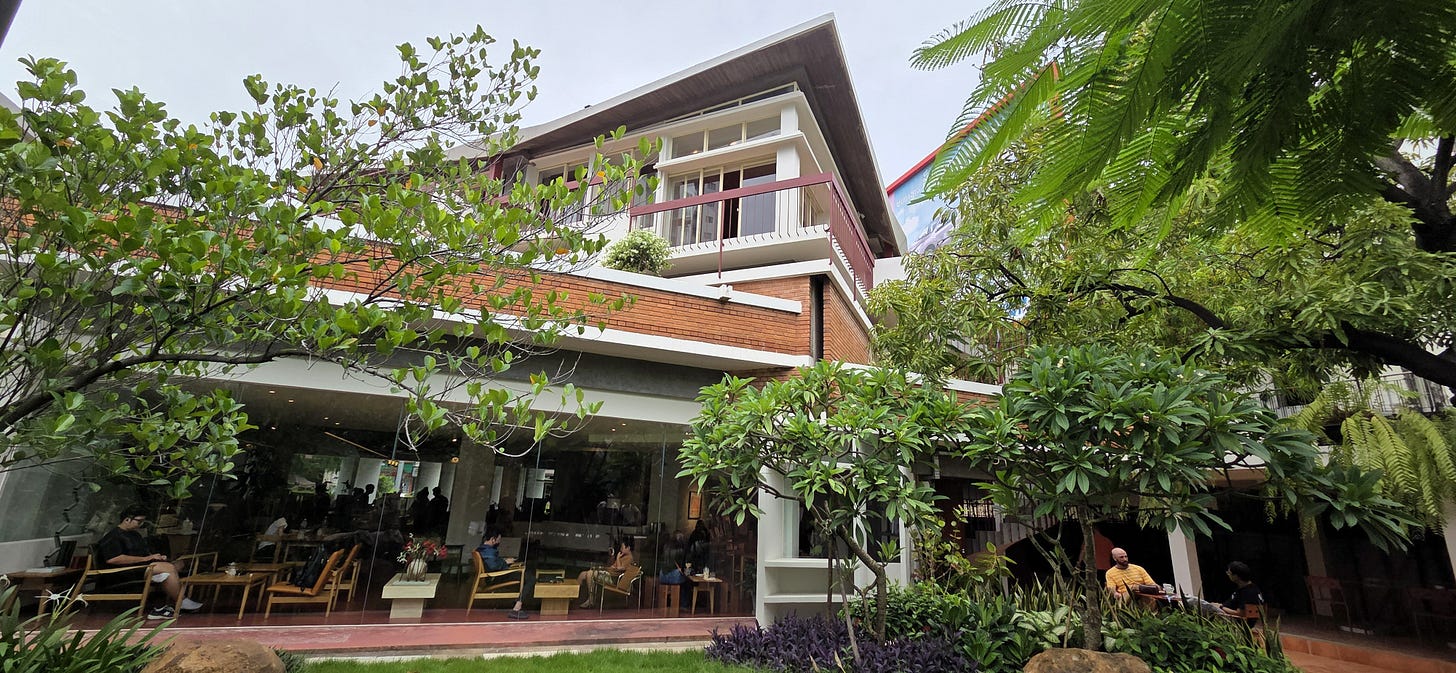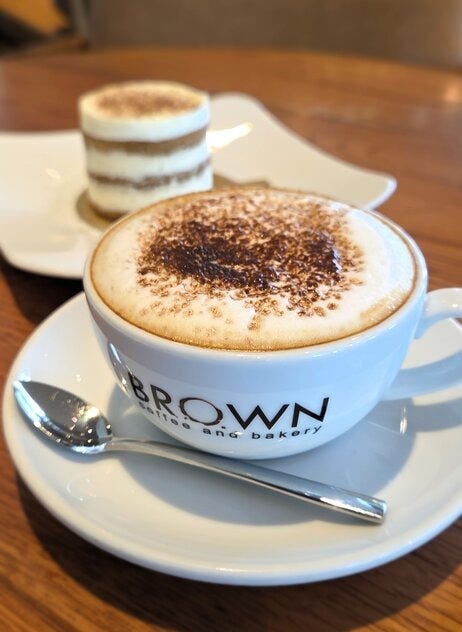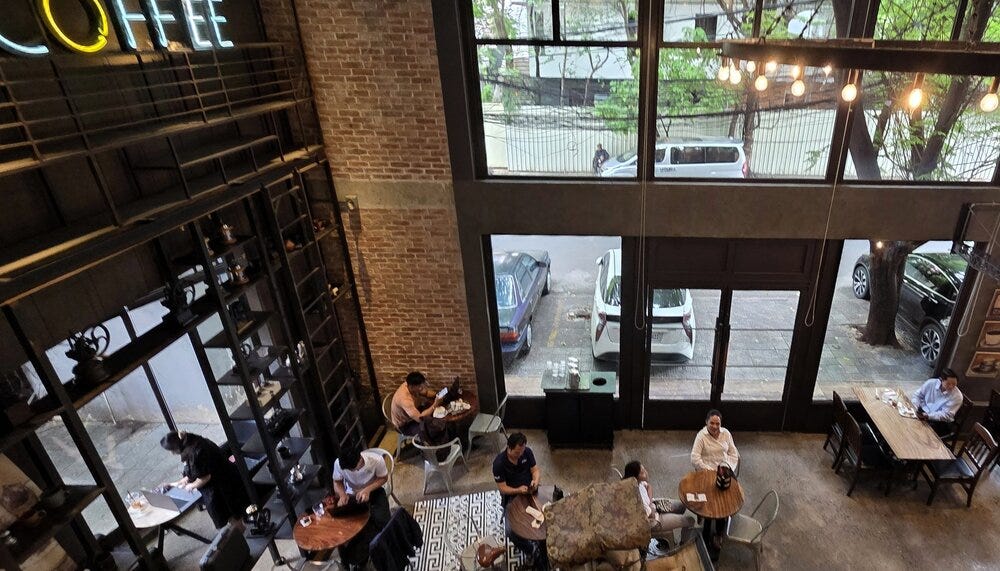The Cambodian Coffee Company With a Soul
How a local coffee chain is preserving Cambodia’s modern heritage — one cup at a time.
As a lifelong Java junkie, one of the first things I noticed in Cambodia was that Starbucks does not dominate the caffeine scene.
In the heart of Cambodia’s frenetic capital, Brown Coffee has become more than just a café; it’s a cultural institution. Since opening its first outlet in 2009, the locally founded chain has helped redefine the Cambodian coffee scene, blending modern sophistication with a deep respect for local tastes.
Brewing a Cambodian Success Story
What began as a small venture by a couple of entrepreneurial Cambodian cousins has grown into a brand synonymous with quality, innovation, and local pride. Brown Coffee now boasts more than 20 outlets across Phnom Penh and other major cities, offering a mix of espresso-based drinks, traditional Khmer beverages, artisanal pastries, and sandwich and pasta offerings at the flagship stores. The beef and mushroom panini, paired with an iced coconut latte, was my go-to lunch three out of five days in Phnom Penh.
Unlike the influx of foreign chains, Brown has rooted its success in understanding the Cambodian consumer. From stylish interiors influenced by Khmer aesthetics to training programs that invest in local talent, the brand has cultivated a uniquely Cambodian identity. “We didn’t want to copy and paste a Western coffee model,” said one of the co-founders in a 2024 interview. “We wanted to build something that felt like home—modern, but ours.”
Brown’s commitment to quality is also reflected in its sourcing practices. The company partners with regional coffee growers, particularly in the provinces of Mondulkiri and Ratanakiri, helping to showcase Cambodia’s emerging specialty coffee industry.
As the country’s middle class grows and café culture flourishes, Brown Coffee continues to expand, recently opening drive-thru locations and experimenting with new digital ordering platforms. Yet, amid growth, it remains a symbol of national entrepreneurship.
A Cup of History
On my third or fourth (or maybe fifth) visit to the Brown Coffee outlet in the BKK1 neighborhood of Phnom Penh, the charming barista asked if I’d ever been to the Brown Coffee outlet located in the home of Vann Molyvann, Cambodia’s most famous architect. “It’s a very special place,” she said. “You should go there for lunch one day.”
I found it tucked away on Mao Tse-Tung Boulevard, overshadowed by monolithic high-rises. The private residence of Vann Molyvann stands as one of Cambodia’s most enigmatic architectural treasures. A product of ambition and introspection, the three-story brick-and-concrete villa has weathered war, neglect, and redevelopment pressures, yet remains a shining testament to the country’s “Golden Age” of nation-building.
In 1966, at the height of his career, Vann Molyvann, then head of state public works and principal architect under Prince Norodom Sihanouk, designed his own home as both studio and sanctuary. It was his rare chance to “play,” boldly experimenting with complex parabolic double roofs, intersecting split-level floors, and a fluid spatial choreography unseen in his more public commissions. The living room, kitchen, and workshops are stripped of conventional walls, instead arranged across five staggered levels, accessed by twin staircases, which gives the interior a labyrinthine, almost theatrical character.
The house embodies the tenets of New Khmer Architecture that he championed, fusing European modernism with traditional Khmer idioms. The hyperbolic double roof, engineered with reinforced concrete and covered in terracotta tiles, keeps interiors cool while flooding them with diffused light. Brick facings and horizontal glass bands reinforce this delicate balance of solidity and transparency.
Climate Consideration
Much like his public works, the Olympic Stadium, Independence Monument, or Chaktomuk Conference Hall, Molyvann designed his home with Cambodia’s climate at its core. Ventilation corridors, broad overhangs, and the cross-breeding of interior and exterior spaces ensure comfort in the tropical heat. It stands rotated about 45 degrees relative to the street, maximizing garden views and distancing the structure from neighboring walls.
Surviving the Khmer Rouge
In many ways, the villa’s journey mirrors the country’s tumultuous history. Within five years of its completion, the Molyvann family fled to Switzerland as civil war erupted in 1971. During the Khmer Rouge era, it was abandoned; later, it was used without care by government offices. Upon returning in 1991, Molyvann found it neglected and derelict, as he recalled, “in a shocking state.” Fortunately, the royal government returned the property to him with the support of King Norodom Sihamoni.
Despite subsequent attempts to repurpose it as a showroom, office space, and more, it was never fully restored until recently. Economic pressures and lax heritage protections have long threatened its survival, but keeping this architectural heirloom intact continues to inspire Cambodia’s younger generation of architects.
Rebirth and Repurpose
In 2025, the villa reopened as Brown Coffee’s flagship outlet. This adaptive reuse, some initially feared, has proven to safeguard the building’s fabric and intent. The renovation retained core structural and aesthetic elements, installing only necessary lighting, paint, and functional fixtures. The café experience, with exhibitions celebrating Molyvann’s legacy, now introduces his work to a broader audience while offering a peaceful garden-facing retreat for visitors.
I sat in the garden and witnessed the steady flow of customers, relaxing with friends, studying for exams, conducting business meetings, and taking selfies in and around this monumental testament to Cambodian pride. You just don’t get that vibe at a Starbucks.
Journalists and architects alike refer to this home as a “domestic manifesto,” revealing Molyvann’s creative soul. It’s not just a monument but a model for equitable, climate-responsive design in Southeast Asia. The villa highlights both the fragility of modern Cambodia’s architectural heritage and the power of imaginative, respectful restoration to breathe new life into buildings that might otherwise be lost. Today, the house stands not merely as a relic or a coffee shop, but as an urgent argument: that modernity must embrace its past, not erase it.
Phnom Penh’s skyline is shifting fast, but Vann Molyvann’s house endures—eloquent, majestic, and unmistakably Cambodian.
In a market where global brands often dominate, Brown Coffee stands out as a homegrown success, serving not just caffeine but a taste of Cambodian ambition and identity.
— Barton Walters, IL’s Thailand Correspondent, reporting from Phnom Penh, Cambodia
Editor’s Note: Bart’s just getting started in Cambodia, and he’ll be sharing more insider tips, local stories, and real costs in upcoming issues of International Living magazine. Don’t miss what he uncovers next — subscribe here for the full story.





